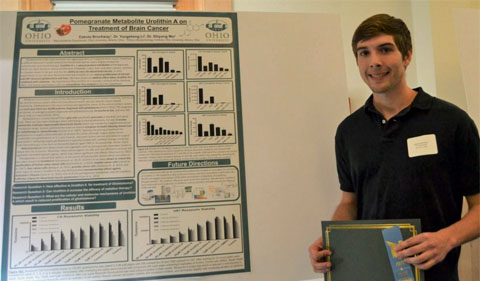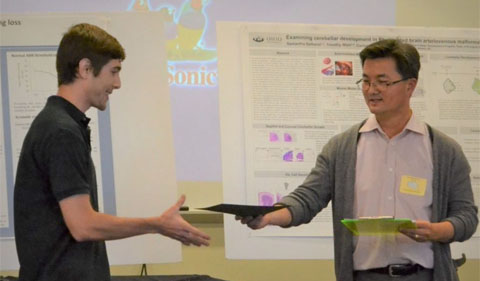
Dakota Brockway won first prize for his poster at Neuroscience Research Day.
Ohio University senior neuroscience major Dakota Brockway is characterizing the properties of a compound that may one day be used as a natural alternative treatment for glioblastoma, the most aggressive form of brain cancer.
The compound, urolithin A, is a polycyclic aromatic metabolite found in several fruits, including pomegranates. Brockway, an Honors Tutorial College student who works under the supervision of OHIO professors Dr. Shiyong Wu and Dr. Yunsheng Li, said the health benefits of pomegranate have long been known. Researchers have identified urolithin A as a molecule with anti-proliferative properties in many types of cancers.
Treatment of brain cancer is very difficult, Brockway said. Generally, treatment involves surgery to excise as much of the tumor as possible, followed by a combination of radiation and chemotherapy. Median survival for glioblastoma patients is just over two years, according to the American Brain Tumor Association.
“Our project could potentially replace chemotherapy – or it could be a new form of chemotherapy that would be natural and safer,” said Brockway, who was recently awarded first prize for the best undergraduate student poster for this project at Neuroscience Research Day.

Biological Sciences professor Daewoo Lee presents Brockway with his award at Neuroscience Research Day.
Urolithin A is of particular relevance to glioblastoma research because, unlike many other potential therapeutics, it can cross the blood-brain barrier and thus would be much easier to administer to patients. Additionally, because the compound is derived from a natural source, Brockway said urolithin A is likely to incur fewer detrimental side effects.
Brockway studies therapeutic effects of urolithin A in cultured rat and human glioblastoma cell lines. He adds the cell culture medium with the compound and measures rates of oxygen consumption and proton production using an extracellular flux analyzer.
The exact mechanism of urolithin A’s known anti-prolific effects are still unknown, but it has been postulated that the drug may help reverse the Warburg effect, the elevation of glycolytic activity in tumor cells. Brockway said that radiation therapy has also been shown to reverse the Warburg effect.
Brockway’s group is currently examining the effects of urolithin A combined with radiation treatment. He said that urolithin A and radiation appear to impart an additive effect (meaning that the overall effect is equal to the sum of the individual effects of the two treatments), and possibly a synergistic effect (meaning that the overall effect is greater than the sum).
“What we know about radiation is pretty limited,” Brockway said. “You see really interesting things in treated cells, (such as changes in) size and morphology. I think that radiation is causing random mutations that are doing a number of things.”
- See more information the Neuroscience program at Ohio University.


















Comments